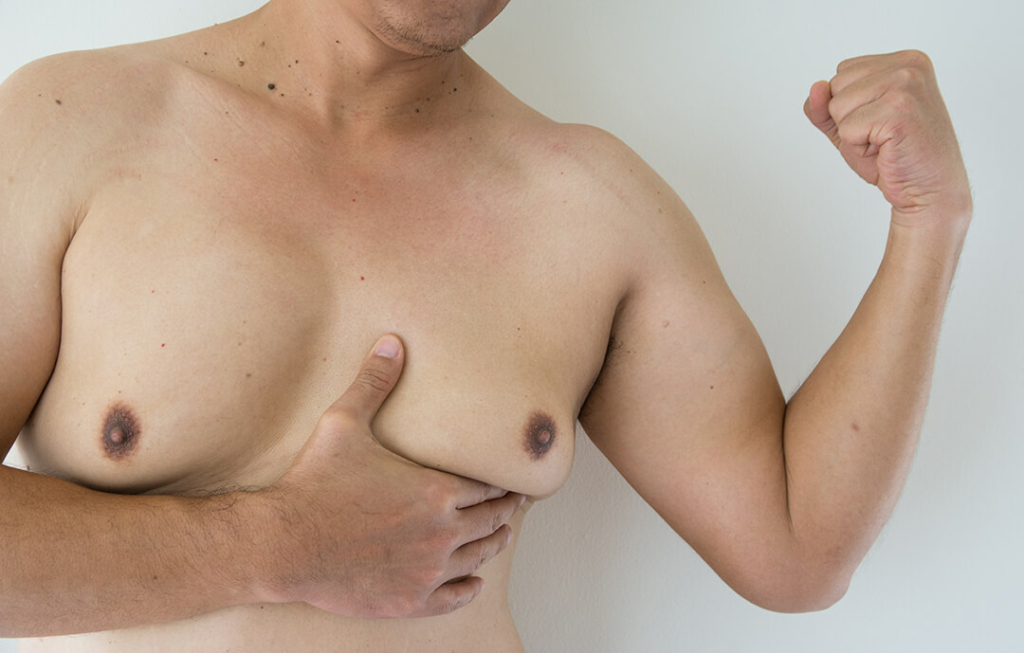As a man, chest fat can be a source of insecurity and frustration. Often, it’s a problem that no amount of diet and exercise seems to eliminate. But what if the root of the issue is deeper than excess fat?
As many as 65% of men struggle with gynecomastia (male breast enlargement disorder) and don’t even know it. The tricky part? It’s easy to assume it’s simply chest fat if you aren’t sure what to look for.
At Dr. Cat Plastic Surgery, we understand the toll that gynecomastia or chest fat can have on your self-image.
Today, we’ll outline the differences in these conditions, their origins, and distinct treatments. Our goal? To help you get back to feeling secure in your own skin.
Gynecomastia vs. Chest Fat: Understanding the Differences
Not sure if you’re struggling with gynecomastia or chest fat? Let’s clear up the confusion.
Gynecomastia (unpleasantly referred to as “man boobs”) refers to the overgrowth of breast glands, connective tissue, and fat in men’s breasts. Chest fat, on the other hand, is exactly what it sounds like—fat that’s accumulated in the chest, usually from excessive weight gain.
But how can you tell which is which? Some distinctions you can make for yourself, include:
- Chest fat feels soft and cushiony, like other fatty areas. Gynecomastia tends to feel a bit firmer and rubbery. It can even feel lumpy, like a button-sized growth near the nipple.
- Fat cells, like in regular chest fat, can respond to exercise and a healthy diet, whereas the fibrous, firm tissue of gynecomastia does not.
- Fat in the chest usually presents as saggy, undefined tissue. Gynecomastia, however, is more defined and contoured. It also tends to be more proportional and round, with a puffy, protruding nipple.
- Gynecomastia can sometimes present in just one breast, while chest fat typically appears evenly in both.
When it comes to diagnosing gynecomastia, most doctors’ first step is to perform a simple pinch test. You can do this yourself by gently pinching or grabbing your breast tissue around the nipple or areola. Feel any lumps or movable tissue? It could be a sign of gynecomastia.
Beyond the basic pinch test, doctors employ urine tests, blood tests, x-rays, and biopsies to diagnose gynecomastia and rule out other conditions.
As for why gynecomastia occurs in the first place…
Causes of Gynecomastia

Gynecomastia can have many potential origins.
While women often experience hormonal imbalance, men actually experience gynecomastia most.
Hormonal Imbalance in Men
The two hormones often linked to gynecomastia development are estrogen (the “female” hormone) and testosterone (the “male” hormone).
While both sexes carry these hormones, it’s the amount we carry that differs. Men tend to have more testosterone, while women have more estrogen. Estrogen, in particular, is responsible for regulating breast size.
In men, however, too much estrogen (as well as a drop in testosterone levels) can lead to the onset of gynecomastia.
Puberty
Gynecomastia is incredibly common in preteen and teenage boys. This is a result of the hormonal fluctuations your body is experiencing. As if being a teenager isn’t hard enough.
Fortunately, this type of gynecomastia tends to go away on its own within a few months to two years.
Certain Medications
Some medications known to trigger gynecomastia include:
- Certain antibiotics
- Estrogen-like substances
- Anabolic steroids
- Ulcer medications
- Antiandrogen drugs
- Tricyclic antidepressants
- Anticonvulsant (epilepsy) medications
- Calcium antagonists
- Heart medicines
- Antiretroviral drugs
- Chemotherapy drugs (particularly alkylating agents)
- Prostate cancer medications
- Antianxiety drugs and antidepressants
Medical Conditions
Gynecomastia can also stem from certain diseases or medical conditions, such as:
- Liver or kidney disease
- Lung cancer
- Testicular cancer
- Adrenal or pituitary gland tumors
- Congenital disorders
- Thyroid disorders
- Injury or trauma
- Obesity
- Neoplasm (abnormal tissue growth)
Another note? While gynecomastia isn’t typically linked to breast cancer, it’s good for your doctor to run the necessary tests to rule it out.
Alcohol and Substance Abuse
Since excessive alcohol consumption can cause alcoholic cirrhosis (alcoholic liver disease), patients can develop secondary gynecomastia as a result.
Other substances that can lead to the development of gynecomastia include marijuana, methadone, heroin, and amphetamines.
While the causes may differ, one thing’s for sure—the emotional challenges that come with gynecomastia (or chest fat) are a shared thread among men grappling with this condition.
The good news? You don’t have to live with that feeling forever.
Gynecomastia Treatments: Surgical vs. Non-Surgical
It’s easy to forget that men can be just as plagued by body image issues as women can be. When it comes to gynecomastia or chest fat, these concerns can have a devastating impact on a man’s sense of self.
Fortunately, you have a variety of gynecomastia and chest fat reduction treatments to help you shed those insecurities and feel great in your own skin once more.
Medical Interventions
When it comes to gynecomastia, the best (and often only) remedy is surgery.
Gynecomastia surgery, also known as a male breast reduction, removes excess breast tissue through a combination of liposuction and skin excision.
“Empowering confidence, one chest at a time: My approach to male breast reduction isn’t just about sculpting a physique, it’s about restoring self-esteem and helping my patients embrace their true selves.” – Dr. Cat
Depending on the underlying causes, other medical treatments can include hormone therapy or estrogen-blocking drugs (like Tamoxifen and Raloxifene).
Lifestyle Changes
While surgery is usually the best treatment for gynecomastia, your lifestyle choices can also play a role in how prominent your chest fat appears.
Diet for Gynecomastia
When it comes to your diet, certain foods have positive effects on balancing your hormones and, in turn, the amount of fatty tissue in the chest.
Here are some of the nutrients you’ll want to prioritize in your daily diet:
- Fish oil (from cold-water fish like tuna or salmon)
- Zinc-rich foods (like meat, shellfish, legumes, and nuts)
- Vitamins E and D (sunflower seeds, bell peppers, mushrooms)
- Milk thistle seeds (supports liver health)
- Anti-inflammatory foods (leafy greens, olive oil, almonds)
Conversely, you’ll want to limit your intake of foods like:
- Soy (contains phytoestrogens, plant-based compounds that mimic human estrogen)
- Processed or fried foods (causes weight gain, and therefore fat growth in the chest)
- Beetroot (increases estrogen levels)
- Frozen foods (contain preservatives that trigger hormonal imbalances)
Chest Fat Exercises
While exercise alone won’t eliminate gynecomastia, it can help enhance the way your chest looks. Plus, exercise boosts endorphins and other brain chemicals associated with feeling happier and more confident.
Some workouts you’ll want to sprinkle into your daily sweat sesh include:
- Cardio exercises to burn fat (like walking or running)
- Full-body exercises with a focus on the upper body (like rowing or swimming)
- Chest exercises to increase pectoral muscles (like bench pressing and push-ups)
A healthy lifestyle might not resolve gynecomastia, but it certainly helps in addressing other factors that might be contributing to its underlying causes.
Reclaim Your Masculine Physique with Dr. Cat
AtDr. Cat Plastic Surgery, we recognize that body image issues are a shared human experience. And being a man? That doesn’t mean you don’t deserve to love the skin you’re in, too.
If gynecomastia is making you doubt yourself, we’re here to show you there’s a better way. As a specialist in breast surgery, Dr. Cat Huang-Begovic has a keen understanding of the contrasting aesthetics between male and female anatomies. Her results? Simply life-changing.
Ready to embrace a new era of bold, unshakable confidence?

